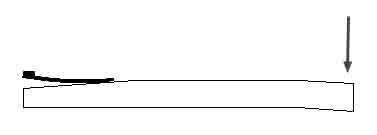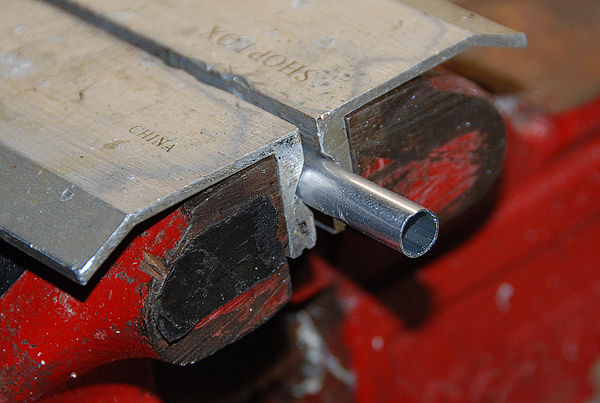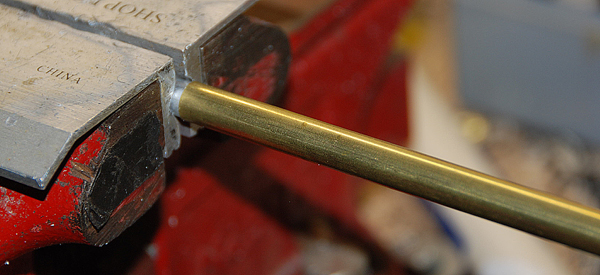
Copyright 2011 David C. Daye
Since the Daye drones are a narrow-bore design enlarged for concert volume, the bass drone reed benefits from the common narrow-bore practice of weighting the free end of the tongue. The tongue has a greater range of swing in vibrating because of this, which enhances the classic narrow-bore "purr."
Since the Daye mainstock is a hollow pipe with the mounting sockets in its endcap, much like the historic narrow-bore drone mainstocks, the reeds have plenty of room for the tongues to swing. But the modern conventional full sized mainstocks are solid wood or plastic with individual reed chambers no wider than the drone tenons. In some cases a Daye style reed tongue can hit the wall of the chamber while vibrating. If that happens, the pitch never becomes steady, tone is bad and the drone stops readily.
The remedy is to make a very slight bend near the drone end of the reed, such that the tongue side of the reed is bent slightly away from the chamber wall.

If you're making a new reed body, do this after creating the tapered flat zone for the tongue so that you can be certain to align the bend properly, but before the tongue is mounted. If you're adusting an existing reed body, it's probably essential to carefully unbind the tongue, making note of exactly where the tone rested and the position where the binding ends on the tongue.
The best way to do this is to clamp the outermost part of the body in some kind of fixture that will support the round tube against crushing, such as these grooved inserts for a vise:

Leave about 1" (or more, if your reed is usually inserted deeper inside the drone's reed socket) outside the mounting clamp. Make sure the tongue-flat on the tube is facing sideways, toward one jaw of the vise or the other.
The Daye bass drone tube bodies are 5/16" outside diameter. So then slide a tube with 5/16" inside diameter (brass thin-wall hobby tube sold as 11/32" outside diameter is probably easiest to find in the US), or a piece of wood or plastic drilled with a 5/16" hole, over the exposed end of the reed body. It's easiest to do with a brass tube at least 12" in length which is available from many hobby shops and some hardware stores, because the length offers enough leverage to bend the reed body easily by a small amount.

It's better to use a sleeve over the outside rather than a 9/32" insert into the inside because the sleeve will preserve the round shape at the open end which must rest inside the reed seat of the drone and seal airtight. The insert will stretch the opening into a slight oval which might prevent it from being inserted far enough into the drone, and makes it difficult to get an airtight seal around the binding. Note the position of the far end of the sleeve; then force it in the direction away from the jaw that the tongue-flat is facing, enough that when it's released, it comes to rest a just a small distance away from its original position.
The angle is probably one, or a very few degrees. Re-bind the tongue onto the reed, put the reed-seat binding back onto the now-bent end and install it back into the drone. If you achieved any detectable bend, the drone will now play strong and steady.